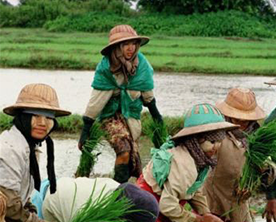Nearly five years ago, Nobel prize winning economist Joseph Stiglitz stated that Myanmar needed to focus on agriculture, since GDP growth that originates from agriculture serves to benefit the poorest half of the population significantly more. In a country where alleviation of poverty is an urgent need, this seems to appeal and an increase in agricultural productivity is perceived to be ‘pro-poor’. Various reports published by international agencies reiterate the big role agriculture can play in Myanmar’s economic development, pushing investment and consumption to higher levels, while improving health and nutrition of the lower segment.
In a country that is largely agrarian, employing around 61 per cent of its labour force, and contributing 36 per cent to the nation’s GDP, development of the agricultural sector makes complete sense. At present, abundant, fertile land and water resources provide the ideal conditions for cultivating a wide range of cash crops and industrial crops including grains, beans, pulses, oilseeds, fruits and vegetables. If Myanmar can adopt and adapt to international best practices, it may soon become a leading food exporter.
Myanmar’s Agricultural Sector
The fact that Myanmar was once the world’s largest rice exporter has not been forgotten, and even today 54 per cent of the crop sown area is devoted to rice cultivation. The 12.8 million hectares under cultivation can increase by at least fifty percent, and the arable land per capita is twice as much as the Asian average. A KPMG report states that Myanmar has ten times the water resources of India or China, its closest neighbours. Agriculture in Myanmar, besides reaping the benefits of abundant fertile land and water supply, also stands to gain from the country’s close proximity to two of the biggest food markets, namely India and China. This access to a ready market makes it imperative to increase exports, raise their quality levels to meet international standards and reduce transportation costs to offer competitive prices.
Currently, the agricultural sector is dominated by small scale paddy farms and paddy accounts for half of the total cropped area. Pulses and oil seeds cover 20 per cent each of the farmed area, and the remaining 10 per cent is used for fruits, vegetables, cereals, root crops and other horticultural products.
The Need for Foreign
Investment Despite the ample advantages that the agricultural sector enjoys, it remains grossly underdeveloped, plagued by low productivity, poor efficiency, scarce monetary resources, undercapitalized and underinvested in.
The agricultural sector needs a large infusion of funds to modernize and generate revenue for farmers and the country. The outdated farming practices used for generations need to be discarded. But mechanization requires funding and poor farmers are cash strapped without access to funds. The main source of financing is the MADB (Myanmar Agricultural Development Bank) which disburses loans and while having an innovative structure, is unable to meet the financing needs of the large number of farmers. Preference is given to rice farmers and even the funds provided do not cover the entire farming cost. The gap and the need is then filled by private individuals and organizations that are part of the informal sector which charge interest on loans up to 20 per cent per month. Such rates lead to an endless cycle of debt and the poor farmers sink further into poverty.
The government has acknowledged that it needs to support the credit requirements of small land holders and farmers, and the role of foreign investment in ‘reintegrating Myanmar into the global economy’. There is a need to improve productivity through a multi-pronged approach, using high yielding variety of seeds, improving irrigation facilities, increasing acreage of more lucrative crops, and provide storage facilities to prevent damage of harvested produce. It is also essential to help farmers get better prices for their crops.
FDI is imperative for setting up agri-based industries that will contribute to value addition and increase profitability, when finished, processed goods are sold in place of raw materials. These industries will also provide employment opportunities to the rural poor, provide opportunities for skill development and improve the standard of living. This will also prevent an exodus towards large cities, which are not yet equipped to handle rapid urbanization. If the rural poor are able to get satisfying jobs in villages, they will continue to stay and their increased earnings will reduce poverty and lead to rural development. Thus agriculture linked industries can begin operations on a small scale for processing, canning, packaging dehydrated powders, soup mixes, snack foods, frozen foods out of fruits and vegetables. If these are set up close to the farms from where these are harvested, it will save on storage and transportation expenses, and only the finished goods will need to be sent to markets and exporting companies. As of now, majority of the agro-processing units are rice processing mills.
Foreign investment can facilitate the setting up of specialized industries, and companies that focus on single products like rice, oilseeds, etc. Bringing in machinery and starting top class processing units, will divert raw materials towards these units and value addition through processing will raise earnings, provide employment and promote capability and skill building. The composition of exports will also change from raw material to processed goods needed by high value markets. For instance, the highest percentage of exports of beans and pulses goes to India, which increases the products vulnerability to a single market. Most of the exports are in raw form, which are then processed in Indian processing units. If the same could be started in Myanmar, the earning potential of this segment would go up substantially.
A close look at developing nations reveals the flow of foreign investment into the industrial sector. But Myanmar as yet does not provide the ideal environment for rapid industrialization due to lack of infrastructure and a major power deficit. Thus, industries cannot take advantage of the low labour costs, and the agricultural sector can benefit.
The Directorate of Investment and Company Administration (DICA) has drawn out a detailed plan to attract foreign investment to increase productivity and improve the quality of agricultural produce. This has opened opportunities for foreign investors in key segments like agricultural input industries, related services, market and product development. An initiative to link the industrial and agricultural sectors will improve the flow of FDI towards agriculture which till now stands at 0.15 per cent of the total. Official figures revealed by DICA state that agriculture received only USD 7.18 million in the last financial year.
Current foreign investment scenario
According to a new report in the Myanmar Times last month, the Myanmar Investment Commission approved investments totalling to US$ 6 billion for the financial year ending 31st March 2017. This includes an approval of foreign investment of around USD 2.5 billion in the first three weeks of January alone. No data was available for the amount allocated for agriculture, out of this.
This reveals a significant increase in FDI levels since 2012. In recent years. China, Hong Kong, Singapore Japan, South Korea, Vietnam and Thailand have been investing in the agricultural sector. While large investors are investing in rubber and palm oil plantations,small and medium scale investments are going into sugarcane, corn, bio fuels, fruit and vegetable plantations. Foreign investors can set up a joint venture with the private sector, or with the public sector. The government is encouraging investment opportunities at every step of the agricultural supply chain, and a significant amount of land has been handed over to foreign companies. While some companies have acquired large plantations, smaller ventures have initiated contract farming. Previous bottlenecks in policies and regulations are consistently being removed. The latest World Bank report highlights Myanmar’s growth limiting factors, which include a narrow production base and a lack of diversification in commodities which cannot meet the requirements of a highly competitive global market. Vulnerability to natural disasters which have led to major setbacks in the past are another limitation faced in Myanmar.
As nations develop, typically, the percentage share of agriculture in the country’s GDP comes down, and so do employment levels, with mechanization reducing the dependence of the sector on labour. However, this may not be the case for Myanmar, which may never see agriculture as its ‘sunset industry’. It will most likely continue as an agriculture based country for a long time, and emerge as a major food supplier in the region.










